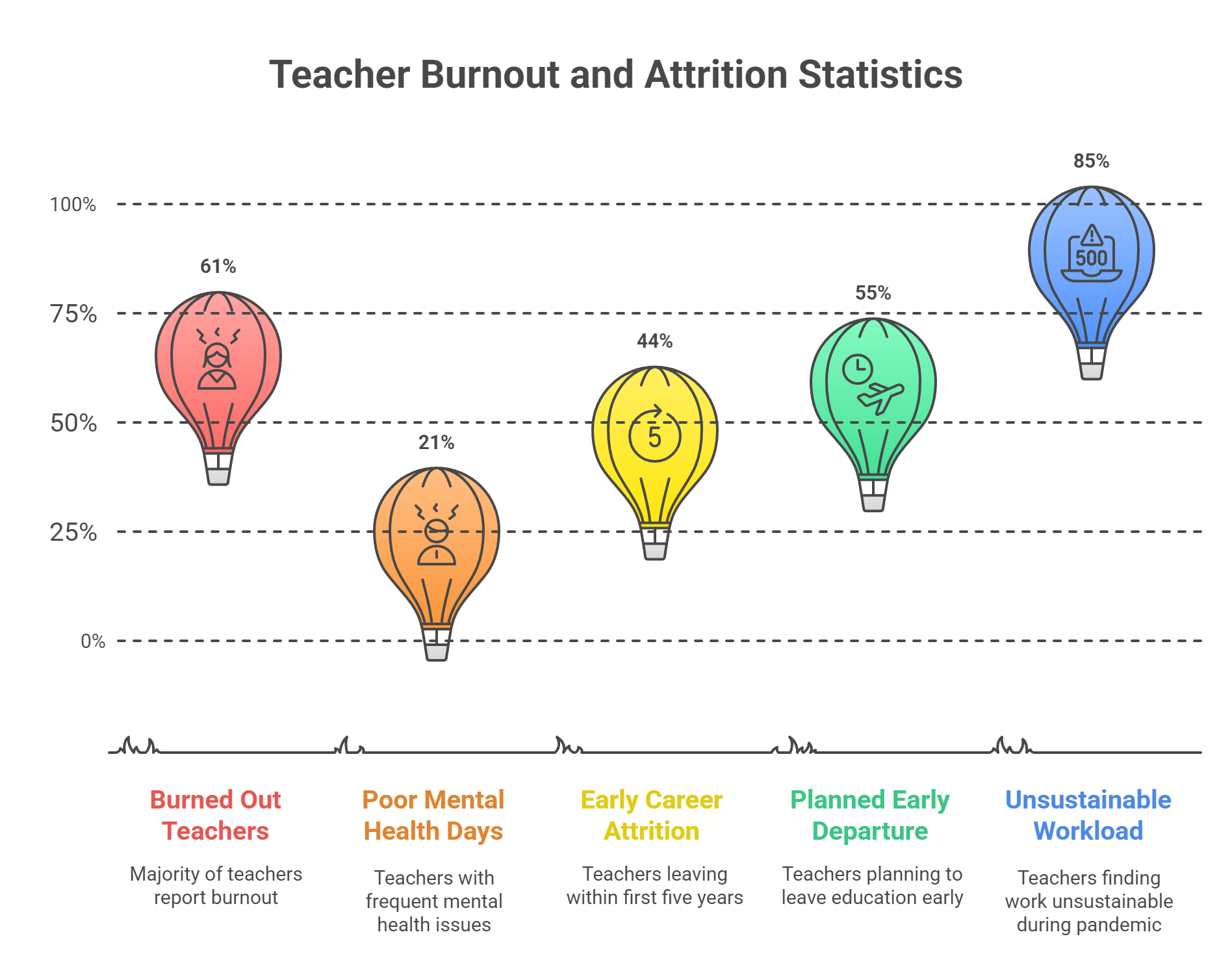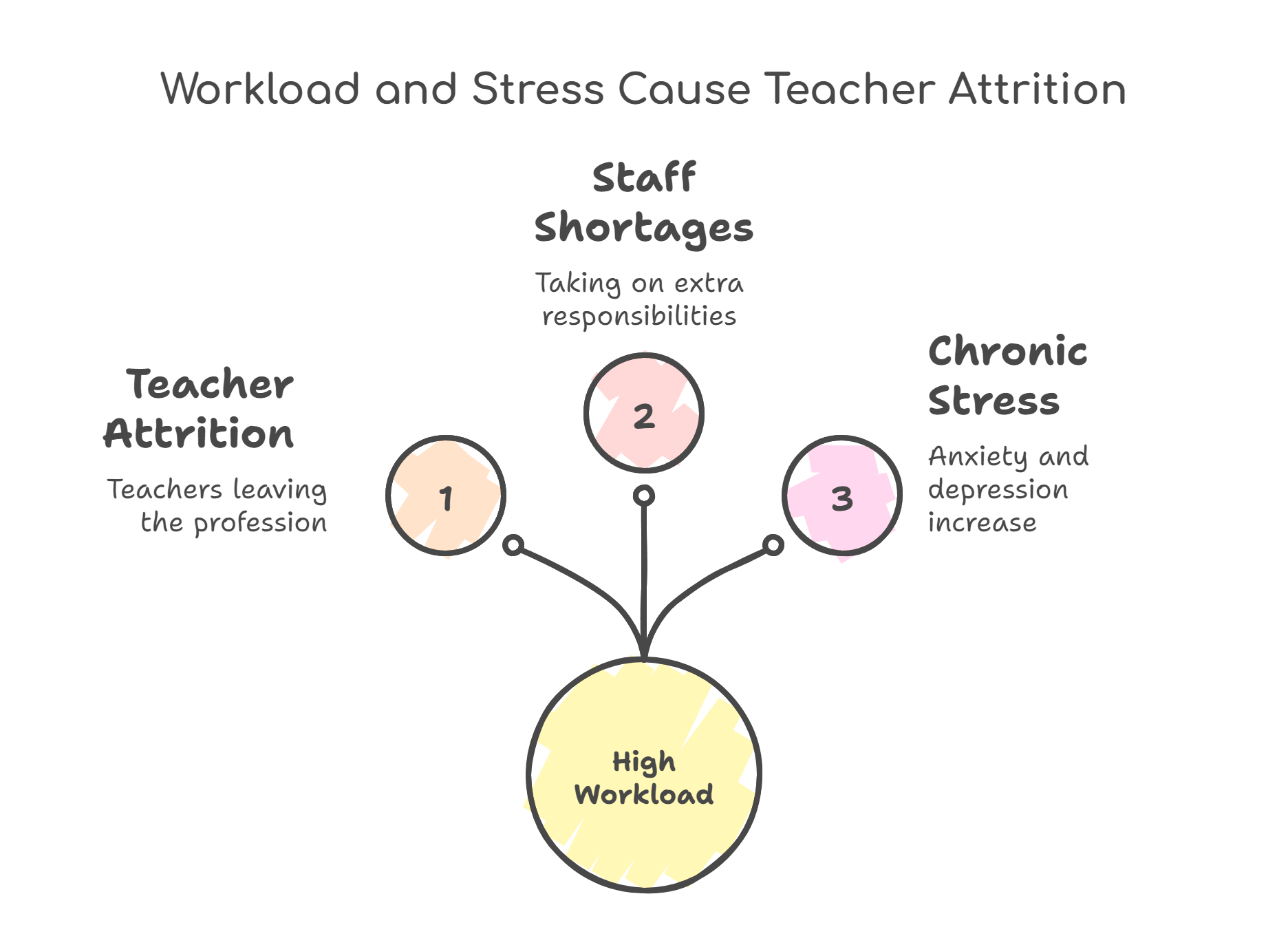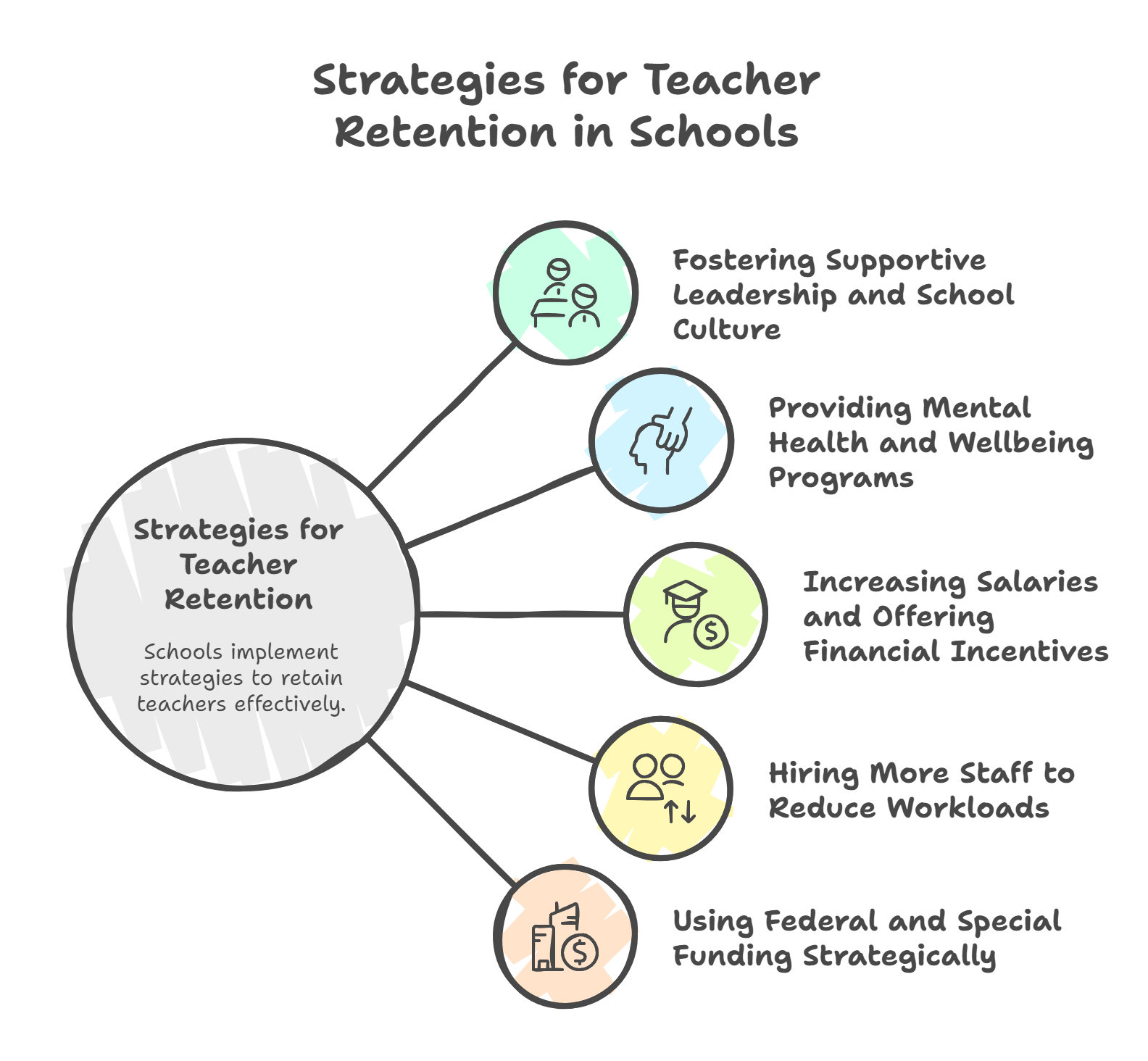Teachers are leaving their jobs in record numbers, prompting an urgent question: what’s driving this exodus from the classroom? While statistics tell one side of the story, the reality is far more personal.
Consider the experience of a teacher who described her Sunday evenings as filled with anxiety, dreading the week ahead, feeling constantly exhausted and overwhelmed, so much so that she’d nearly burst into tears over something as small as the wrong dinner side dish.
During the week, she ran out of energy for her own family after a day managing classroom challenges and relentless demands at school. Eventually, this stress and burnout took its toll, and she found herself reconsidering a career she once dreamed about.
This article examines the root causes behind the trend and real solutions that keep our educators in classrooms where they’re most needed.
Key Takeaways
Teacher burnout is a major issue, with 33% of teachers experiencing high levels of stress, significantly impacting their well-being and effectiveness.
Key factors driving teacher attrition include compensation issues, increased workload, and lack of administrative support, with many teachers feeling undervalued.
The COVID-19 pandemic exacerbated teacher retention challenges, leading to staffing shortages and increased mental health struggles among educators.
Understanding Teacher Burnout
Teacher burnout, low pay, lack of support, excessive administrative burdens, and insufficient resources are major factors driving teachers to leave the profession. The emotional toll and lack of work-life balance significantly contribute to attrition.
According to a study conducted by the Multidisciplinary Digital Publishing Institute (MDPI), about 33% of teachers experience high levels of burnout, highlighting the severity of this issue.
Burnout significantly impacts teachers, leading to higher absenteeism and affecting their well-being and teaching effectiveness. Many sacrifice their mental, emotional, and physical health, resulting in exhaustion and unhappiness. Often, teachers feel consistent dread about their careers, indicating it may be time to reconsider their profession.
Poor health can worsen burnout, creating a vicious cycle. Job-related stress affects teachers’ sleep, their ability to enjoy time with loved ones, and their mental and physical health. And this cycle explains why many teachers leave the profession.
Statistics on Teacher Burnout

Teacher burnout is a pervasive issue, with recent studies painting a grim picture. According to a recent study, a staggering 61% of teachers reported feeling burned out, with 21% experiencing poor mental health for more than 11 days each month. This highlights the severe impact of burnout on teachers’ mental health.
The problem is particularly acute among newer teachers. The same study found that 44% of teachers leave the profession within the first five years, with newer teachers being 2 1⁄2 times more likely to quit than their tenured counterparts.
Additionally, a survey by the National Education Association revealed that 55% of teachers plan to leave the education field sooner than they had originally planned.
The reasons cited include lack of support, poor working conditions, and low pay. These factors, combined with the stress of the job, make it difficult for many teachers to see a long-term future in the profession.
The COVID-19 pandemic has only exacerbated these issues. An alarming 85% of teachers described their work as “unsustainable” during the pandemic, with many claiming it significantly increased risks to their health.
Key Causes Behind Teacher Attrition
Teacher attrition has multiple causes. About 37% of teachers plan to leave their current schools within the next four years, indicating a retention challenge. In the 2022-23 school year, 23% either left their roles or transferred to another school within their district.
Former teachers often share their experiences and insights through various platforms, emphasizing the need for improved conditions in schools to retain educators.
High turnover rates are especially noticeable in the school system serving economically disadvantaged students, which lost 29% of their teaching staff during the 2022-23 academic year, according to school boards.
The reasons behind this attrition are complex, but three main factors stand out: compensation issues, increased workload and stress, and lack of administrative support.
Let’s delve into each of these causes in more detail.
Compensation Issues
Salary dissatisfaction is a significant reason for teachers leaving. Many struggle to cover basic expenses, leading to financial stress that compounds professional challenges. Despite increasing workloads, teacher salaries haven’t risen accordingly, making many feel undervalued and underpaid.
Public school teachers average just over $63,500, with starting salaries barely exceeding $40,000. This is significantly less than peers in similar professions, where teachers earn nearly 20% less.
Additionally, teachers often pay out-of-pocket for classroom expenses, averaging $500 per year, further driving them to consider better-paying jobs.
Increasing teacher salaries is essential for retaining talented educators. Without adequate compensation, attracting and keeping teachers, especially in economically disadvantaged areas, remains challenging. Better pay could alleviate financial stress and make teaching more sustainable.
Increased Workload and Stress

The overwhelming workload and stress significantly contribute to teacher attrition. About 38% of teachers find their work often stressful, reflecting high demands. Many use weekends to catch up on classroom work, highlighting unrealistic expectations and workloads.
Staff shortages worsen the problem, with 74% of teachers taking on extra responsibilities due to lack of staff. As more teachers leave, remaining ones face increased workloads, leading to more stress and burnout. High expectations for test scores while managing classroom behavior add further pressure, making a healthy work-life balance difficult.
Long hours and overwhelming demands can lead to chronic stress, anxiety, and depression, affecting teachers’ well-being and their ability to educate effectively.
Lack of Administrative Support
Inadequate support from school administrators significantly contributes to teacher attrition. Many report that lack of administrative support drives them out of the classroom. Therefore, effective leadership is vital for managing classroom behaviors and preventing burnout.
Teachers frequently cite micro-management and lack of autonomy as factors in a negative working environment. Lack of input in their professional practice makes them feel undervalued and unsupported. Schools with toxic climates see significantly higher stress levels, contributing to burnout beyond just administrative support issues.
Effective leadership and a supportive environment are essential to make teachers feel valued and heard. Adequate support can mitigate stress and improve job satisfaction, fundamental to supporting teachers and retaining them.
Poor Working Conditions and Safety Concerns
Many teachers face poor working conditions that make their jobs even more challenging. Outdated textbooks, inadequate technology, and insufficient resources are common issues in many schools. These conditions hinder teachers’ ability to provide quality education and contribute to their frustration and burnout.
Safety concerns are also a significant issue. According to a study, 70% of public schools reported at least one violent incident during the 2019-2020 school year. This statistic highlights the prevalence of violence in schools and the risks teachers face daily.
Teachers are not only dealing with disruptive student behavior but also facing physical threats. A concerned 29% of teachers reported being physically attacked or threatened by a student in the past year. These incidents create a stressful and unsafe working environment, further driving teachers to consider leaving the profession.
Addressing these poor working conditions and safety concerns is important for improving teacher retention. Schools need to invest in better resources and create safer environments to support teachers and ensure they can perform their jobs effectively.
Impact of the Pandemic on Teacher Retention
The COVID-19 pandemic profoundly impacted teacher retention. The sudden shift to hybrid teaching and lack of preparation increased overall stress, and many teachers considered leaving due to this heightened stress and health concerns.
Between February 2020 and May 2022, about 300,000 public school teachers and staff left the profession, which is about 3% of the workforce. By 2022, there were 567,000 fewer educators in public schools compared to pre-pandemic levels, highlighting the pandemic’s significant impact on teacher attrition.
The pandemic increased feelings of unsafety among teachers, with 13% concerned about COVID-19 rule implementation. The rapid need to upskill for hybrid teaching added stress, leading to resignations and staff shortages.
Mental Health Struggles Among Teachers
Mental health issues like anxiety and depression are prevalent among teachers, with rates significantly higher than in the general population.
Low job satisfaction is closely linked to increased burnout, anxiety, and depression among teachers. Many feel powerless and cynical, exacerbating burnout and mental health struggles. Chronic stress and burnout can lead to serious physical health problems, making it hard for teachers to continue in their roles.
Addressing these challenges requires comprehensive support, including access to mental health professionals and better job satisfaction initiatives.
The Role of Student Behavior
Student behavior significantly influences teacher attrition. Increased misbehavior creates greater challenges in classroom management, contributing to teacher stress.
Burnout often leads teachers to revert to less effective methods, aggravating classroom disruptions. This creates a cycle where student behavior worsens, increasing teacher stress and attrition rates.
Effective classroom management strategies and support from administrators are needed to address student behavior issues. A positive and cooperative classroom environment can reduce teacher stress and improve retention.
Limited Career Growth Opportunities
Limited career growth opportunities frustrate many teachers, contributing to attrition. Many feel a lack of clear pathways for advancement, leading to stagnation and dissatisfaction. Schools often fail to communicate future career possibilities during hiring, which can demotivate teachers.
Career advancement opportunities, like distributive leadership models, can significantly improve retention by providing progress and development. Without these, many seek professions with better growth potential, driving them away from teaching.
Enhancing professional development and clearly outlining career pathways can help retain talented educators. Schools must invest in teachers’ growth to cater to long-term commitment and job satisfaction.
Better Financial and Career Prospects Elsewhere
Better financial and career prospects in other fields also drive teachers to quit teaching. They explore alternative careers like instructional design, curriculum development, or educational consulting, finding better financial stability and job satisfaction, which sometimes leads to quitting the teaching profession.
These careers often offer competitive salaries and professional growth opportunities lacking in teaching. Transitioning teachers typically experience greater fulfillment and financial security, making the move appealing.
Changing Demographics and Student Needs
The demographics of the student population are changing, presenting new challenges for teachers. Increasing numbers of students from diverse backgrounds, including English language learners and students with disabilities, require specialized support and resources. However, many teachers feel ill-equipped to meet these needs.
The changing demographics also bring new challenges, such as addressing the needs of students who have experienced trauma or are struggling with mental health issues.
Teachers are often on the front lines, providing mental health support and counseling services without adequate training or resources. This additional responsibility can be overwhelming and contribute to burnout.
To address these challenges, schools need to provide better training and resources for teachers. Investing in professional development and support systems can help teachers meet the various needs of their students and reduce the stress and burnout associated with these responsibilities.
Parental Pressure and Lack of Support
Teachers are facing increasing pressure from parents, which can contribute to feelings of frustration and burnout. A significant 55% of teachers report feeling undervalued and unsupported by parents. This lack of support can make it difficult for teachers to feel confident and effective in their roles.
The pressure from parents often comes with high expectations that teachers feel unable to meet. This pressure can be particularly challenging when combined with the already demanding nature of the job.
Teachers also face pressure from school administrators, with many feeling micromanaged and undervalued by their administrators. This lack of autonomy and support can lead to feelings of powerlessness and frustration, further contributing to teacher burnout.
To address these issues, schools need to introduce a supportive environment for teachers. This includes providing autonomy, recognizing their efforts, and creating open lines of communication with both parents and administrators.
What Schools Are Doing to Retain Teachers

To address the growing issue of teacher attrition, schools are actively implementing various strategies aimed at improving job satisfaction, reducing burnout, and creating a supportive workplace.
Key measures include:
Fostering Supportive Leadership and School Culture
Effective leadership plays a critical role in teacher retention. School leaders who cultivate a positive and respectful environment help teachers feel valued and supported. This includes promoting open communication, recognizing achievements, and encouraging collaboration among staff to build strong professional relationships.
Providing Mental Health and Wellbeing Programs
Recognizing the emotional toll teaching can take, many schools are introducing mental health initiatives such as counseling services, stress management workshops, and wellness programs.
Increasing Salaries and Offering Financial Incentives
To make the teaching profession more attractive and sustainable, schools are advocating for and using funds to increase teacher pay and provide bonuses or stipends. Oftentimes, competitive compensation is key to retaining talented educators.
Hiring More Staff to Reduce Workloads
Recruiting additional teachers and support personnel eases the burden on individual educators by distributing responsibilities more evenly. This helps reduce burnout caused by overwhelming workloads and excessive administrative tasks.
Using Federal and Special Funding Strategically
Funds from initiatives like the American Rescue Plan are being allocated toward recruitment and retention efforts, including paying for bonuses, hiring incentives, and professional development.
Why Teachers Are Quitting Wrapped Up
The reasons behind high teacher attrition rates are complex and interwoven. Factors such as burnout, inadequate compensation, overwhelming workloads, lack of support from administration, mental health challenges, student behavior difficulties, limited opportunities for career growth, and more attractive alternatives outside teaching all contribute to the current crisis.
Addressing these issues requires teamwork and commitment from all stakeholders in education. Solutions that center on supporting teachers not only improve retention but also helps educational quality for students.
Together, we can create a sustainable and rewarding environment where teachers feel valued and motivated to continue shaping generations to come.
Frequently Asked Questions
What is the #1 reason teachers quit?
The primary reason teachers quit is burnout, which stems from prolonged stress, overwhelming workloads, and lack of support. This leads to emotional, mental, and physical exhaustion, driving many educators to leave the profession in search of better work-life balance.
What is the real reason for teacher shortage?
The real reason for the teacher shortage is multifaceted, involving inadequate compensation, increased responsibilities, and lack of administrative support. These factors, combined with the impact of the COVID-19 pandemic, have led to a significant decline in teacher retention rates.
Why do people not want to be teachers anymore?
People are increasingly reluctant to enter the teaching profession due to high levels of stress, low pay, and limited career growth opportunities. The challenging work environment and lack of support further deter potential educators from pursuing teaching as a viable career path.
Why are teachers losing their jobs?
Teachers are primarily losing their jobs due to budget cuts, decreasing student enrollment, and evolving educational priorities. Additionally, the emphasis on increased accountability and rigorous performance evaluations has heightened job insecurity within the education system.



